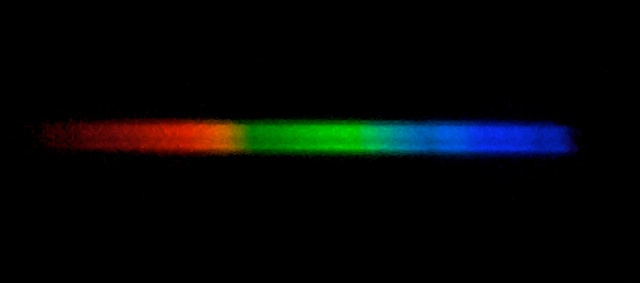
More D7000 DSLR Spectroscopy Tests
Posted: 9 October 2011
Saturday, 8 October, was still clear. Opened Cassiopeia Observatory at 1734 MST, 81°F. About 25 minutes before sunset, I SYNCed the AutoStar on the star Altair and then slewed to Mercury. I finally saw Mercury at 1745 MST in the 26mm eyepiece; it showed a nice round disk. I then went to Venus; it showed a slightly gibbous disk. I tried for Saturn, but it was too low, too faint, and too close to the sun, which was still above the horizon. At 1758 MST, slewed to the waxing gibbous moon. I took this iPhone 4 photo of the moon at 1801 MST. It is afocal, 26mm eyepiece, with the MX-1 afocal adapter.

I then did some lunar terminator observing with the 15mm eyepiece. There was not much of a terminator visible this night. Seeing was still affected by the daytime atmospheric heating. I also took a tour over the rest of the moon's disk. There were some nice views. I then began waiting for the sky to get darker.
At 1905 MST, I connected the SkyWire serial cable to the 8" LX200-ACF and connected the iPhone 4. I used SkySafari 3 Pro to locate and GOTO to the asteroid Vesta. Viewed it with the 26mm eyepiece, and then had the iPhone tell the telescope to GOTO the asteroid Ceres. It was very handy to use the iPhone for GOTOing objects, especially with the problem with the MODE key on the Wireless AutoStar II handcontroller, which won't reliably show the MODE display to allow entry of RA/Dec coordinates. I then disconnected the iPhone and at 1910 MST, viewed Neptune. The disk was easily seen with the 26mm eyepiece. I tried using 9.7mm and 5.5mm eyepieces but the seeing was not good enough for steady views. The view of Neptune was best using the 15mm eyepiece. At 1916 MST, viewed Uranus in the 15mm eyepiece; disk easily seen.
I then began setting up for a second night of D7000 DSLR spectroscopy tests using the loaner Star Analyser. I attached the Star Analyser + spacer to the camera prime focus adapter. With the camera mounted on the telescope, I first went to the star Altair. A few Fraunhofer lines were seen in the camera viewfinder, so I knew that seeing was better for this night's tests. I took this 1/30sec, ISO 1600, exposure:

During post-processing, I used the technique mentioned in the Star Analyser manual:
"Crop the image so it just shows the strip with the spectrum (it will typically only be a few pixels high). Resize the strip to the same width but only one pixel high, then resize again to the same width but 30 pixels high."
Here is the result:
Not too bad! Lines appear clearly now.
I also imaged the stars Vega and Fomalhaut, 1/30sec, ISO 1600. Here are their processed sprectra:
The spectral types are similar, so their spectra appear similar, with some slight differences. I plan to do more star spectra imaging over the next few nights to collect some additional Spectral Types.
I ended imaging at 1948 MST. I viewed the star Fomalhaut with the 9.7mm eyepiece and Star Analyser + spacer. A few lines were faintly visible. I then went to Vega and viewed it; could not see any lines. I guess the Star Analyser is not ideal for visual use without a slit.
I removed the Star Analyser and took a quick look at Jupiter at 1958 MST. It had just risen above the hill and so was still low in the sky. Seeing was not good but the four Galilean Moons were visible. I then went back to the moon for a final look. Seeing was a little better now than it had been earlier in the evening. I used the 9.7mm and 5.5mm eyepieces for some terminator viewing. The view was best with the 9.7mm (206X) eyepiece, with some really excellent shadows of mountains and craters.
The observatory was closed at 2015 MST, 55°F.
Go to the previous report.
Return to the Cassiopeia Observatory Welcome Page.